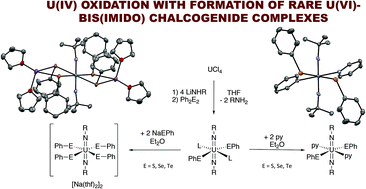Oxidation of uranium(iv) mixed imido–amido complexes with PhEEPh and to generate uranium(vi) bis(imido) dichalcogenolates, U(NR)2(EPh)2(L)2†
Abstract
This work provides new routes for the conversion of U(IV) into U(VI) bis(imido) complexes and offers new information on the manner in which the U(VI) compounds form. Many compounds from the series described by the general formula U(NR)2(EPh)2(L)2 (R = 2,6-diisopropylphenyl, tert-butyl; E = S, Se, Te; L = py, EPh) were synthesized via oxidation of an in situ generated U(IV) amido–imido species with Ph2E2. This synthetic sequence provides a general route into bis(imido) U(VI) chalcogenolate complexes, circumventing the need to perform problematic salt metathesis reactions on U(VI) iodides. Investigation into the speciation of the U(IV) complexes that form prior to oxidation found a significant dependence on the identity of the ancillary ligands, with tBu2bpy forming the isolable imido–(bis)amido complex, U(NDipp)(NHDipp)2(tBu2bpy)2. Together, these data are consistent with the view that the bis(imido) U(VI) motif – much like the uranyl ion, UO22+ – is a thermodynamic sink into which simple ligand frameworks are unable to prevent uranium from falling when in the presence of a suitable retinue of imido proligands.

- This article is part of the themed collection: Challenges in organometallic & coordination chemistry: in celebration of Geoff Cloke’s 65th birthday


 Please wait while we load your content...
Please wait while we load your content...
